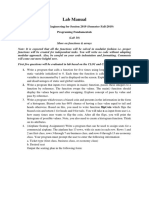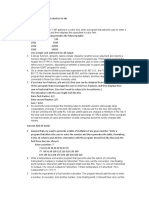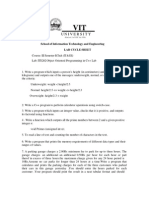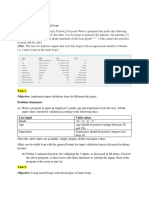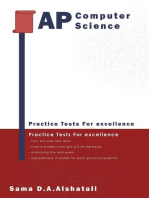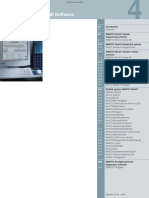STAT 740 - Spring 2004 - Homework 1: Accov - For
STAT 740 - Spring 2004 - Homework 1: Accov - For
Uploaded by
cementsaimCopyright:
Available Formats
STAT 740 - Spring 2004 - Homework 1: Accov - For
STAT 740 - Spring 2004 - Homework 1: Accov - For
Uploaded by
cementsaimOriginal Title
Copyright
Available Formats
Share this document
Did you find this document useful?
Is this content inappropriate?
Copyright:
Available Formats
STAT 740 - Spring 2004 - Homework 1: Accov - For
STAT 740 - Spring 2004 - Homework 1: Accov - For
Uploaded by
cementsaimCopyright:
Available Formats
STAT 740 - Spring 2004 - Homework 1
Due: Friday, January 30th
Note: Problems 1 and 2 require computer code. A hardcopy is not needed. Please e-mail me the
(uncompiled) code so that I can compile and run it to verify that it works. Neither of these two
programs involve issues of efficiency, nor do they require additional comment lines except for
the date of last modification and your name.
1) The accov.for program we’ve seen in class does not currently force the user to enter an
integer when asked for the item numbers. Because of this the program could be caused to crash
by entering a non-integer or by entering an integer with a too-large or too-small value. A
subroutine called chartoint is available on the course web-page (currently demonstrated
inside of another program). This subroutine is designed to ask the user to enter a non-negative
integer value in a specified range, and then to force them to do it.
For this problem, include this subroutine in accov.for and modify the program to use the
subroutine. Note that you should also change the 999 to quit option to a more logical non-
negative integer choice as well.
2) We saw in class what happens to the INTEGER*1 format when values are accumulated one at a
time (e.g. 127+1=-128). How does the computer deal with cases of multiplication though?
Write a program to calculate 64x2, 64x3, 64x4, 64x5, 65x2, 65x3, 65x4, and 65x5 and store the
values in the integer*1 format and then print them out. Can you tell how it seems to be
handling the multiplication? (Binary work is not required.)
3) Imagine we were working with an INTEGER*3 variable using two’s complement notation.
What would the largest (most positive) and smallest (most negative) values representable by this
notation be? Give the numbers and their representations.
4) Represent 3 and 1/16 in IEEE single precision floating point representation like we used in
class.
5) Determine the value of the largest number representable in IEEE single precision floating
point by calculating the decimal value corresponding to:
S=0 E=11111110 F=11111111111111111111111
You can report in scientific notation with at least four decimal places instead of carrying it all the
way out.
6) Imagine that you want to add a list of several thousand real numbers of various magnitudes
together. In what order would you add them together to guarantee that you would get the
smallest rounding error possible? Give a brief example using a short list of numbers. (Note:
No programming needed, and the answer isn’t just to add them from smallest to biggest!)
You might also like
- Homework 2Document4 pagesHomework 2RonyVargasNo ratings yet
- Math Quiz Bee Questions: Arnel Bontuyan Molina, M. EdDocument1 pageMath Quiz Bee Questions: Arnel Bontuyan Molina, M. Edimelda ardiza86% (7)
- C++ Programming ExercisesDocument6 pagesC++ Programming Exercisesragunath32527117No ratings yet
- Exercise Questions Finals-2Document22 pagesExercise Questions Finals-2Faiza AliNo ratings yet
- OOP With C++ (Assignment - 3) CSE, 3 Semester: Prepared By: Deepak Uniyal (Assistant Professor CSE, GEU)Document2 pagesOOP With C++ (Assignment - 3) CSE, 3 Semester: Prepared By: Deepak Uniyal (Assistant Professor CSE, GEU)Govind TripathiNo ratings yet
- C++ Exercise For FunctionsDocument4 pagesC++ Exercise For FunctionsHaider SultanNo ratings yet
- CPPDocument6 pagesCPPfsdvNo ratings yet
- HW 12Document5 pagesHW 12David M RodgersNo ratings yet
- Assignment 1Document6 pagesAssignment 1Tashfeen AbbasiNo ratings yet
- Lab and Home Assignment Sheet - 2022Document10 pagesLab and Home Assignment Sheet - 2022Koushik DebnathNo ratings yet
- C++ Lab ManualDocument38 pagesC++ Lab Manualdashingdude218172No ratings yet
- Cycle Sheet 2010 11 Latest!Document10 pagesCycle Sheet 2010 11 Latest!Gaurav SinhaNo ratings yet
- Lab Exercise-Basic JavaDocument12 pagesLab Exercise-Basic JavaSabari NathanNo ratings yet
- Assignment #01 Operators, Conditional Statements, Loops, Functions, Arrays, Pointers and Structures Object Oriented Programming - LabDocument8 pagesAssignment #01 Operators, Conditional Statements, Loops, Functions, Arrays, Pointers and Structures Object Oriented Programming - LabAhmed ShareefNo ratings yet
- Home Assignment 2Document3 pagesHome Assignment 2Fatima ChaudhryNo ratings yet
- Python Lab FileDocument23 pagesPython Lab Fileeshanpadhiar3No ratings yet
- EEE2109 Final Spr2021Document3 pagesEEE2109 Final Spr2021tanvirm6985No ratings yet
- Workshop6Function1 95176Document2 pagesWorkshop6Function1 95176rahulshah23100No ratings yet
- Object Oriented Programming Oops Lab ManDocument39 pagesObject Oriented Programming Oops Lab ManRashid MehmoodNo ratings yet
- Binayakarki (IPPS Workshop6)Document13 pagesBinayakarki (IPPS Workshop6)shrayan shresthaNo ratings yet
- C# .NET AssignmentsDocument10 pagesC# .NET AssignmentsshivuhcNo ratings yet
- Step 2 - Java - MustDo - ExercisesDocument15 pagesStep 2 - Java - MustDo - ExercisesPriyanka AgarwalNo ratings yet
- EECE 230 Programming Using C++ Sections 1, 2, 3 Lab Assignment 5Document2 pagesEECE 230 Programming Using C++ Sections 1, 2, 3 Lab Assignment 5dNo ratings yet
- List of Practical For Class XI Computer Science 2024-25Document3 pagesList of Practical For Class XI Computer Science 2024-25chaudharyanukarshNo ratings yet
- List of Practical for class 11 Computer Science 2023-24Document2 pagesList of Practical for class 11 Computer Science 2023-24unusual1131No ratings yet
- MIT6 189IAP11 hw2Document8 pagesMIT6 189IAP11 hw2Ali AkhavanNo ratings yet
- Taller Laboratorios Módulo 4 PythonDocument11 pagesTaller Laboratorios Módulo 4 PythonSantiago RiveraNo ratings yet
- MP 1Document4 pagesMP 1VienNgocQuangNo ratings yet
- Python AssignmentDocument3 pagesPython Assignmentaliveolivia6No ratings yet
- PCP Lab QuestionsDocument6 pagesPCP Lab Questionsmuthavarapu.sohithNo ratings yet
- IT2 Lab5 TasksDocument3 pagesIT2 Lab5 TasksAndrei ImashauNo ratings yet
- C++ Lab ExercisesDocument8 pagesC++ Lab ExercisesSeravana KumarNo ratings yet
- Lab 02Document3 pagesLab 02jscansinoNo ratings yet
- Computer Science 37 HW 2Document5 pagesComputer Science 37 HW 2Alexander TaylorNo ratings yet
- University: School of Information Technology and Engineering Lab Cycle SheetDocument10 pagesUniversity: School of Information Technology and Engineering Lab Cycle SheetAbhas TandonNo ratings yet
- LAB ManualDocument40 pagesLAB ManualMarumamula Santosh KumarNo ratings yet
- Lab 2Document5 pagesLab 2amnamehmoodbwpNo ratings yet
- Java Programming Tutorial 1Document10 pagesJava Programming Tutorial 1Akisseh Ngunde NnamNo ratings yet
- COL100 Lab 5: ObjectiveDocument5 pagesCOL100 Lab 5: ObjectiveSiddharth KumarNo ratings yet
- Verilog Assignment List1 PDFDocument4 pagesVerilog Assignment List1 PDFramu jampulaNo ratings yet
- Assignment 2: COMP202, Winter 2021 Due: Friday, March 12, 11:59pmDocument23 pagesAssignment 2: COMP202, Winter 2021 Due: Friday, March 12, 11:59pmMuhammad Hamza AminNo ratings yet
- Python AssignmentDocument6 pagesPython AssignmentLuke RobinsonNo ratings yet
- Ict133 Jul 2021 ToaDocument8 pagesIct133 Jul 2021 Toachim101347No ratings yet
- Col106 A2Document4 pagesCol106 A2Akshat JhaNo ratings yet
- Practical PythonDocument16 pagesPractical PythonmaxicolynoNo ratings yet
- ProbDocument1 pageProbApam BenjaminNo ratings yet
- Module 2: Problem Solving Techniques Unit 1Document7 pagesModule 2: Problem Solving Techniques Unit 1Alipriya ChatterjeeNo ratings yet
- Computer Programming 143: Universiteit Stellenbosch UniversityDocument9 pagesComputer Programming 143: Universiteit Stellenbosch UniversityYemukelaniNo ratings yet
- Exercise-02 BooleansDocument3 pagesExercise-02 Booleansast56erxNo ratings yet
- Lab Printouts CSE - AIML & DSDocument15 pagesLab Printouts CSE - AIML & DSgajulasureshNo ratings yet
- 6phrase - Myslate - InfyTQ & HackWithInfy - Programs ListDocument15 pages6phrase - Myslate - InfyTQ & HackWithInfy - Programs Listraghava leeNo ratings yet
- Homework and Pre Lab 12Document11 pagesHomework and Pre Lab 12Syed Asad Asif HashmiNo ratings yet
- Midterm Sample QuestionsDocument11 pagesMidterm Sample Questionslai20230092No ratings yet
- HW 8Document2 pagesHW 8Huy NguyenNo ratings yet
- Programming Assessment 1Document4 pagesProgramming Assessment 1Arthur YeungNo ratings yet
- Practice Exercise (Loops)Document6 pagesPractice Exercise (Loops)Muhammad Nasir Awan ZakariyanNo ratings yet
- Java Practice Programs - NewDocument10 pagesJava Practice Programs - NewKalyan SwaroopNo ratings yet
- AP Computer Science Principles: Student-Crafted Practice Tests For ExcellenceFrom EverandAP Computer Science Principles: Student-Crafted Practice Tests For ExcellenceNo ratings yet
- Collection of Raspberry Pi ProjectsFrom EverandCollection of Raspberry Pi ProjectsRating: 5 out of 5 stars5/5 (1)
- Practical Numerical C Programming: Finance, Engineering, and Physics ApplicationsFrom EverandPractical Numerical C Programming: Finance, Engineering, and Physics ApplicationsNo ratings yet
- CE ChisholmDocument5 pagesCE ChisholmcementsaimNo ratings yet
- Cse 5A Introduction To Programming (C/C++) Homework 2Document2 pagesCse 5A Introduction To Programming (C/C++) Homework 2cementsaimNo ratings yet
- Opc0401 eDocument2 pagesOpc0401 ecementsaimNo ratings yet
- LivebookDocument20 pagesLivebookcementsaimNo ratings yet
- Consequences of Applying Tunneling To OPC: Roman Kwiecień, Leszek SZYCHTADocument4 pagesConsequences of Applying Tunneling To OPC: Roman Kwiecień, Leszek SZYCHTAcementsaimNo ratings yet
- OPC Server Config Technical - NoteDocument9 pagesOPC Server Config Technical - NotecementsaimNo ratings yet
- Communication Between PLC Different Vendors Using OPC Server Improved With Application DeviceDocument8 pagesCommunication Between PLC Different Vendors Using OPC Server Improved With Application DevicecementsaimNo ratings yet
- Suitelink Systemplatform TopserverDocument23 pagesSuitelink Systemplatform TopservercementsaimNo ratings yet
- OPC Quick Client HelpDocument25 pagesOPC Quick Client HelpcementsaimNo ratings yet
- DDE Client DriverDocument15 pagesDDE Client DrivercementsaimNo ratings yet
- AppxcDocument6 pagesAppxccementsaimNo ratings yet
- WorldView-3 EngDocument3 pagesWorldView-3 EngcementsaimNo ratings yet
- Practical Guide To OpcuaDocument53 pagesPractical Guide To OpcuacementsaimNo ratings yet
- WorldView 4Document6 pagesWorldView 4cementsaimNo ratings yet
- Siemens Simatic WinCC SCADA 2009Document92 pagesSiemens Simatic WinCC SCADA 2009cementsaimNo ratings yet
- Datasheet Wonderware OIServer 05-17Document4 pagesDatasheet Wonderware OIServer 05-17cementsaimNo ratings yet
- Opc Ua Client Made EasyDocument4 pagesOpc Ua Client Made EasycementsaimNo ratings yet
- Atmel 3392 CNFG At17f16 Datasheet-1368777Document15 pagesAtmel 3392 CNFG At17f16 Datasheet-1368777cementsaimNo ratings yet
- Top View SCADAConnect Users GuideDocument116 pagesTop View SCADAConnect Users GuidecementsaimNo ratings yet
- Features of PVSS II v3Document38 pagesFeatures of PVSS II v3cementsaimNo ratings yet
- Aug 0048 00 Poll Data From Siemens PLC Using Ethernet ProtocolDocument20 pagesAug 0048 00 Poll Data From Siemens PLC Using Ethernet ProtocolcementsaimNo ratings yet
- Maharashtra Common Entrance Test: (Maha Cet)Document17 pagesMaharashtra Common Entrance Test: (Maha Cet)shishir badveNo ratings yet
- 4-4 Study Guide and Intervention: Complex NumbersDocument2 pages4-4 Study Guide and Intervention: Complex NumbersasdfasdfasdfasdfasdfNo ratings yet
- 5.4-5.7 Quiz 2Document1 page5.4-5.7 Quiz 2conwaymichael2008No ratings yet
- Chapter 2 - Measures Central TendencyDocument20 pagesChapter 2 - Measures Central Tendency1974 Kazi SatiNo ratings yet
- DLD QBDocument5 pagesDLD QBSai Nath Reddy NerusupalliNo ratings yet
- Arithmetic AlgorithmDocument16 pagesArithmetic Algorithm69Sutanu MukherjeeNo ratings yet
- Computer ArithmeticDocument57 pagesComputer Arithmeticbe adabNo ratings yet
- AssignmnetNo 1Document5 pagesAssignmnetNo 1Shubham BendeNo ratings yet
- Ratio and Proportion Are Explained Majorly Based On FractionsDocument8 pagesRatio and Proportion Are Explained Majorly Based On FractionsmehalaNo ratings yet
- Negative Numbers Homework Year 6Document7 pagesNegative Numbers Homework Year 6dhbrvxsif100% (1)
- MLL Class X MathsDocument115 pagesMLL Class X Mathsrsrautela1997No ratings yet
- Adaptive Approximation in Arithmetic Circuits A Low-Power Unsigned Divider DesignDocument6 pagesAdaptive Approximation in Arithmetic Circuits A Low-Power Unsigned Divider DesignShweta RaoNo ratings yet
- Siera Task-InvarianceDocument1 pageSiera Task-Invariancebeng51264No ratings yet
- Tutorial: Checksum and CRC Data Integrity Techniques For AviationDocument44 pagesTutorial: Checksum and CRC Data Integrity Techniques For AviationversineNo ratings yet
- Module in Mathematics 6: (WEEK 7)Document6 pagesModule in Mathematics 6: (WEEK 7)Melford estañolNo ratings yet
- Chapter 3 Data StorageDocument51 pagesChapter 3 Data StorageMaya DanaNo ratings yet
- 4.ũrdhva TiryagbhyāmDocument9 pages4.ũrdhva Tiryagbhyāmshuklahouse100% (1)
- General Mathematics 11 Module 2 2021Document17 pagesGeneral Mathematics 11 Module 2 2021Mica Ella OlivarNo ratings yet
- Common Step - Java Most Asked Coding Questions and AnswersDocument11 pagesCommon Step - Java Most Asked Coding Questions and Answersabdul MuqtadirNo ratings yet
- Number System Resonance Rmo-NsejsDocument13 pagesNumber System Resonance Rmo-NsejsIshita PandeyNo ratings yet
- Cambridge Lower Secondary Mathematics Progression Grid Tcm143-592637Document61 pagesCambridge Lower Secondary Mathematics Progression Grid Tcm143-592637Adonai David RaharjoNo ratings yet
- Math Matters - Understanding The Math You Teach, Grades K-8Document16 pagesMath Matters - Understanding The Math You Teach, Grades K-8AliNo ratings yet
- 7th Standard Maths Vte Exam PaperDocument4 pages7th Standard Maths Vte Exam PaperJesus CaresNo ratings yet
- MOD 2 NewDocument6 pagesMOD 2 Newfahira aisyahNo ratings yet
- NCERT Solutions Class VI MathematicsDocument391 pagesNCERT Solutions Class VI MathematicsROHIT K ANILNo ratings yet
- Number System - CRACK SSC PDFDocument11 pagesNumber System - CRACK SSC PDFSai Swaroop AttadaNo ratings yet
- 2ndMonthlyExam T.anaDocument9 pages2ndMonthlyExam T.analorinjaycorona43No ratings yet
- Properties of Exponents & Radicals ReviewDocument2 pagesProperties of Exponents & Radicals ReviewJohn-Rey ManzanoNo ratings yet
- Ch. 11 Practice SolutionsDocument7 pagesCh. 11 Practice SolutionsDavid EucedaNo ratings yet





